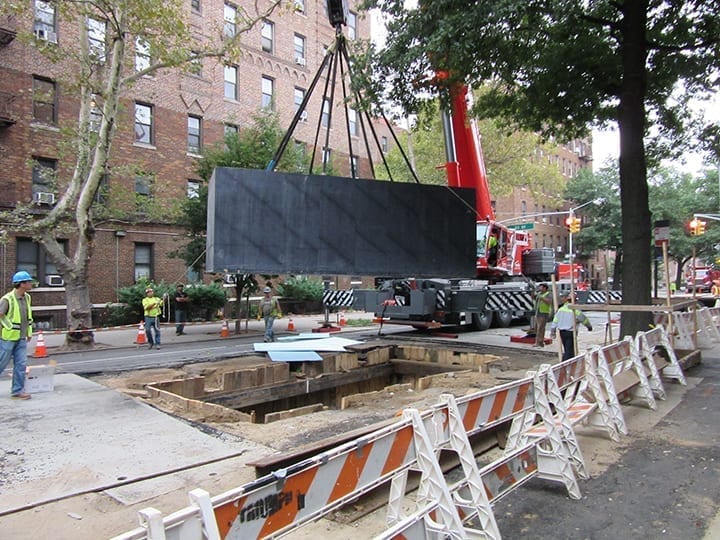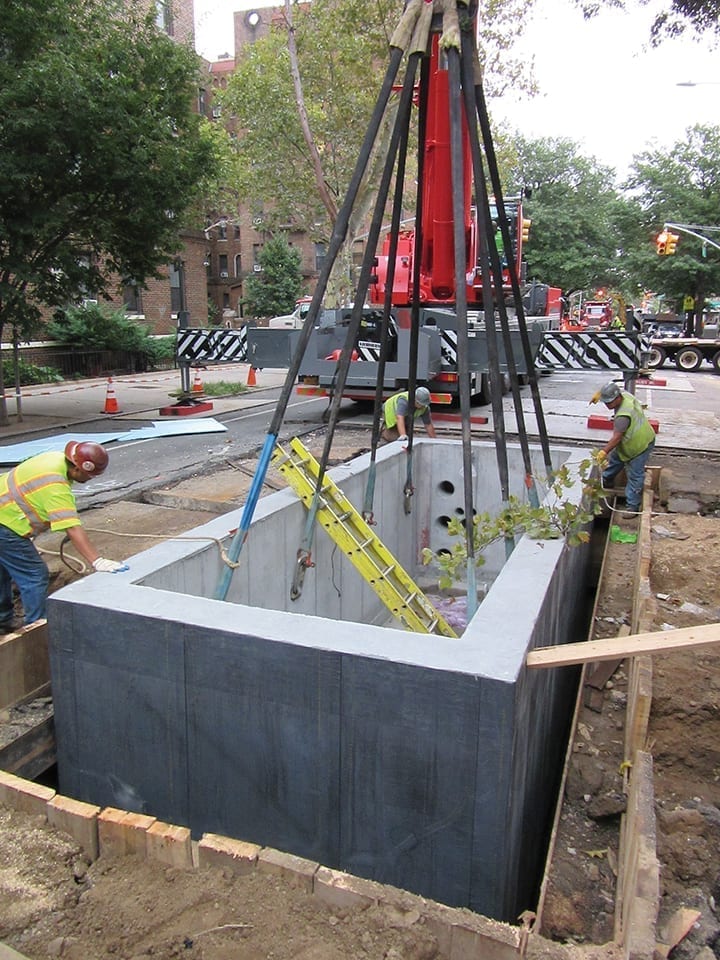Useful Specifications and Guides for Underground Cable and Vaults
Underground electrical cable systems are used by power companies around the world. Two recently updated specifications and guides provide system designers and engineers with important information to ensure a lifetime of satisfactory performance for these systems.
The Association of Edison Illuminating Companies (AEIC) was founded in 1885 by Thomas Edison and his associates. The group, which is one of the oldest organizations in the electric energy industry, encourages research, and the exchange of technical information and best practices, through a committee structure staffed with experts and volunteer engineers from AEIC member companies.
Some of the earliest urban applications of the Edison system were the installation of underground electrical cable systems. Today, AEIC’s Cable Engineering Committee (CEC) continues to develop and improve underground electrical systems by publishing detailed cable specifications and guides that are followed by utilities, architects, engineers, and developers worldwide. The AEIC’s cable specifications and guides give vital information for manufacturers of electrical cables, while providing the electric industry and other electrical system users with clear and concise data to specify underground cables, connectors, and whole underground systems, as well as guiding the proper installation, maintenance, and operation of these systems.
The CEC also monitors the production of cable manufacturers and acts as an advocate for electric utilities. Its affiliations with other electrical engineering organizations and testing facilities allow it to gather information about cable systems’ operation and reliability, and apply best practices across the electric utility industry.
“Each member brings unique experiences that have made our specifications and guides essential to utility engineers. Through collaboration, this committee has been able to create specifications that drive manufacturers to build more reliable products and our specifications have been referenced in purchasing specifications all across the world,” said Najwa Abouhassan, manager of Distribution Standards at ComEd and chair of AEIC-CEC.
U.S. utility representatives with more 100 years of extensive field construction and maintenance experience worked on the following publications.
Cable Specification 8 (CS8)
One of the CEC’s recently published specifications is the fifth edition of CS8 “Specification for Extruded Dielectric, Shielded Power Cables Rated 5 Through 46 kV.” This specification is voluntary and is written as a supplement to the American National Standards Institute (ANSI) and Insulated Cable Engineers Association (ICEA) industry standards.
A key CEC goal is to ensure that the level of cable performance utilities have come to expect over many years of positive field experience is at least maintained or preferably improved at a reasonable cost. The CEC defines the present level of performance in terms of the physical and electrical properties of the cable that member companies receive from their cable manufacturers. These properties are determined via a review of production certified test reports (CTRs) and, for many members, by physical inspection and measurement of completed cable samples prior to cable acceptance.
Many of the revisions in the 2020 version of CS8 have been added based on the CEC’s findings during the aforementioned review process. A few of the significant changes to this revision are described briefly in the following paragraphs.
Insulation Cure. The elongation requirement shown in ANSI/ICEA standards defining adequate curing of some cross-linked polyethylene (XLPE)-based insulation was changed from 175% to 120%. A statistical review of CTR data, as described earlier, revealed that 120% was a more appropriate, yet still conservative, value. In addition, three specimens from the inner 25% of the cable insulation must now be tested rather than just one. Furthermore, one of those specimens must be harvested from insulation adjacent to the conductor shield, where adequate curing is often harder to achieve, yet this is the area that experiences the highest operating temperatures. An extreme failure of this test from a member company’s cable order is shown in Figure 1. Note how the specimen on the right is touching the oven floor, while the specimen on the left, which was obtained from nearer to the middle of the cable insulation, appears normal.
 |
|
1. Insulation cure (hot creep) test of three samples from within the inner 25% of the cable insulation. Courtesy: National Electric Energy Testing, Research and Applications Center (NEETRAC) |
Partial Discharge Test Procedure. Some CEC members and cable testing/commissioning service providers have reported new cables not passing field partial discharge commissioning tests. Some failures of this type can be attributed to inadequate degassing of the cable core prior to electrical production testing as this limits the effectiveness of these tests. The CEC has changed the requirements for degassing to ensure that no additional layers (such as metallic shield, except round wires, or jacket) are applied to the core during the wait period (normally seven full days). If certain conditions are met, wait times may be less than seven days depending on insulation wall thicknesses. The CEC is continuing to evaluate this requirement and may make additional revisions.
CTRs. The CEC has defined minimum reporting requirements for CTRs. The CEC has also required that any in plant repairs or rework of cables be documented on the CTR. CEC members have observed occasional core damage on reworked cables. An example of this situation is a jacketing application problem where the shield and jacket are stripped from the core and reapplied.
Monthly Continuous Vulcanization (CV) Line Requalification. The monthly CV requalification process was put in place years ago as a way to extend the original manufacturer’s CV qualification to other CV lines the manufacturer operates. The CEC has noticed that the testing and reporting associated with this requirement is often completed three to six months after samples are drawn. The requalification test is intended to be a real-time requalification and speedy evaluation of the test results is intended to allow the manufacturer to notice negative manufacturing trends so that problems can be addressed before production test failures occur. In this revision, the CEC has initially limited the lag time for testing and reporting to three months. In addition, test limits have been revised, failure reporting requirements have been defined, and a means to requalify a failed CV line has been added.
The CEC continues to monitor the cable manufacturing industry performance in real time and will continue to review data and make necessary changes to CS8. AEIC specifications are intended to be revised or reaffirmed every five years.
Cable Guide 14 (CG14)
Another of the CEC’s recently published specifications is the first edition of AEIC CG14 “Guide for the Design of Transmission Vaults.” This guide covers the design variables that should be considered when specifying vaults for pipe-type and extruded dielectric-shielded power cable systems rated at 69 kV and above.
As U.S. power utility representatives, the CEC recognized that the need for this underground vault design guide was long overdue and took action to create it. Proper vault design and construction are important to minimize lifecycle maintenance and inspection expenses. The information in this guide identifies variables that assist in vault design, vault placement, construction, and maintenance.
There are many aspects of underground cable vault design that each utility must consider. Location of the vaults, their structural integrity, and their ability to perform intended functions during cable circuit service life are the main criteria for successful design and installation. Utilities with underground transmission circuits will utilize vaults for cable pulling, splicing, cable and pipe anchoring, components testing, and maintenance.
There are two main types of vaults for underground cables. First, vaults for high-pressure pipe-type (HPPT) cables (Figure 2), and second, vaults for solid-dielectric (SD) and self-contained (SC) cables (Figure 3).
 |
|
2. High-pressure pipe-type (HPPT) vault. Courtesy: Consolidated Edison of New York (Con Edison) |
 |
|
3. Solid-dielectric (SD) and self-contained (SC) cables vault. Courtesy: Con Edison |
The CEC recognizes differences in utility approaches to the number of circuits in a single vault, grounding scheme, water sealing, and other factors. That is why the CEC decided to create a guide and not a specification. Each utility has unique challenges when developing the optimal vault design, depending on the cable design, the cable route, and other external aspects.
The guide addresses these factors with discussions on vault concrete and material specifications, suggested dimensions, location considerations concerning soil parameters, available space, conflicts, and other field conditions. It also discusses structural installation considerations (Figure 4 and 5) for highway, seismic, external, and internal loading. In addition, this guide examines several techniques of corrosion mitigation of the metals installed in vaults including cable racks and clamping systems, ladders, link boxes, the rebar in the concrete itself, and any other metals required to be installed in the vault. These techniques include coating systems, corrosion inhibitors, anodes, and chloride extraction.
 |
|
4. Vault installation. Courtesy: Con Edison |
 |
|
5. Vault installation. Courtesy: Con Edison |
The guide is an excellent starting point for new circuit design with underground vaults. It will navigate engineers through vault design development and highlight important questions that must be answered during this process.
CEC guides and specifications are constantly updated based on emerging new materials, industry practices, and questions from utility engineers. AEIC guides are intended to be revised or reaffirmed every seven years.
A Wealth of Information
AEIC CG14, CS8, and 18 other cable specifications and guides are available by visiting AEIC’s website (www.aeic.org) and clicking on the “Cable Specs” heading. The link takes users to AEIC’s interactive store, where cable specifications and guides, as well as the AEIC Load Research Manual, may be purchased in either a printed edition, digitally, or both.
The AEIC consists of 181 member companies, providing leadership and expertise for the organization’s seven committees, five subcommittees, and Data Analytics Council. These operating workgroups have more than 550 members, voluntarily working for the electric industry. For more information about AEIC, contact Regina Crump ([email protected]) or call (205) 257-3839. ■
—Mike Smalley is with WEC Energy Group and is the Task Group Chair for CS8, Paul Jakob is with Duke Energy and is the Task Group Chair for CG14, and Arie Makovoz is with Con Edison and is on the Task Group for CG14.